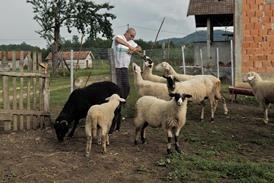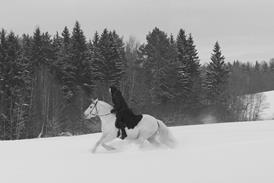Writer discusses collaborating with director Garth Davis and avoiding sentimentality on the awards-contending drama.
Australian writer Luke Davies had a challenging but rewarding task to adapt Saroo Brierley’s memoir A Long Way Home into the feature film script for Garth Davis’ feature debut Lion.
The film tells the incredible true story of how Brierley was separated from his family in rural India as a young child and adopted by an Australian couple. Decades later, he found his birth mother with the help of Google Earth.
Producers Iain Canning and Emile Sherman of See-Saw Films had previously worked with Davies on Anton Corbijn’s Life (2015). Davies is also a poet and novelist – he co-wrote the script to 2006’s Candy, which starred Heath Ledger and Abbie Cornish, based on his 1997 novel of the same name. The Weinstein Company’s awards-season contender stars Dev Patel, Nicole Kidman, Rooney Mara and young Sunny Pawar.
In this interview, Davies tells Screen about the challenges of developing a story set half in India and half in Australia; how he avoided sentimentality; and what Saroo has in common with WALL-E.
When you were first approached about Lion, what excited you about telling this story?
It had a mythic structure: “Reunification with the lost mother”. That’s one of the earliest stories from the mists of time. There are only a few: “The warrior killed the beast”; “The brother killed the brother”; “The son killed the father”. And yet, at no point in the history of human civilisation, until 10 years ago when Google released the Google Earth app, could this story have happened. So it felt like a modern myth, too.

What was your collaboration like with Garth?
I love the man dearly. He’s not just a fine director; he’s quite the radiant, transcendent being as well. Everyone falls in love with Garth. Hang around with him for even five minutes and you’ll say the dominant qualities he emits are joy, wonder and enthusiasm.
What were your thoughts about the tone and how to avoid it playing like a Hallmark card?
I’m not a sentimentalist. I loved the gritty toughness of the story, in its moment-by-moment details. Pure peril for little Saroo; a more complicated anguish for his adult self. I knew I was in good company: neither Garth nor See-Saw are prone to syrup. It’s nice to begin a creative process with a whiteboard and a broad structure, knowing that the mission statement is “unflinching”. And that a company like See-Saw Films will support you in that. There were many bad paths a story like this could take. Tone, we knew, would make or break this film.
Did you think about different approaches to the structure before settling on this one?
I believed strongly that we should begin at the beginning, in the literal sense. Hollywood financing wisdom would say, “Establish your adult star actors, set their context, then loop back when necessary, via flashback, to the story at its beginning.” But it was clear we were dealing with a fable that could hold its own weight, so to speak. I said to See-Saw, “Let’s begin with a five-year-old non-professional actor speaking in Hindi with English subtitles for the first 50 minutes of the film, before we even meet ‘the adults’ [the characters played by Dev Patel, Nicole Kidman, David Wenham and Rooney Mara].” Hats off to See-Saw: they essentially said to Garth and me, “We support you, even on the less obvious ideas.”

The film has to shift momentum when the story moves from India to Australia, how did you deal with that?
The momentum shifts but not the psychic focal point from which the audience is experiencing Saroo’s inner consciousness, his drive, the “search”. If we’ve done our job in the first half, then there’s only one question in your mind as the second half begins: “How will this kid ever find home?” The narrative is like a locomotive that somehow manages to reverse on a dime, and now everything’s charging back to the point of origin.
How did your own research trip to India shape your work?
It was very helpful at practical levels. Saroo took me around all the places where all the real events happened: the railway station, the river, the bridge, the orphanage, his hometown, the dam, the platform, the rain tank. So I got a vivid sense of the geography of it all.
But the biggest shaping of my work was when he took me to Kamla, his biological mother. That was a profoundly moving experience. Four of us in this tiny room: Kamla, Saroo, the interpreter and me. I asked questions; the interpreter translated them; Kamla answered, and wept. She wept non-stop for two hours. In the end, I was apologising before, not after, every question. I needed to ask her everything I could think of. I was triggering a cascade of memories and emotions. It was awkward. It was also this amazing privilege.
What happened to me in that room was a huge shift. The story moved from my head to my heart, or my gut.
The Indian half of the film is absorbing because we’re seeing it through young Saroo’s eyes, but obviously there’s not as much dialogue involved. Was that a unique way to work as a writer?
I’m sure not unique. I loved that weird, beautiful, somewhat obscure Nicolas Winding Refn film, Valhalla Rising. The star, Mads Mikkelsen, doesn’t have a single line of dialogue; the script must be 10 pages long.
In Lion, Little Saroo wanders about this hostile, dangerous Calcutta but there was a lot of narrative information to describe. I had fun, trying to make Saroo’s “stranger in a strange land” exile the right mix of haunted, poetic and perilous. I thought a little of WALL-E, too – the little robot, wandering around alone. Little Saroo, dodging and weaving through a hostile Calcutta. But I don’t want to labor that point. In WALL-E, it’s not chaos in the first act, and ultimately, the tone is rather whimsical. There’s no whimsy in Lion’s first act. There are child sex traffickers. There’s danger on every corner.
Did working on Lion help you grow as a writer?
It did. Something to do with the elemental aspect. In its barest bones, the real story was already stripped away of its frills. I tend to be, in early drafts, an over-writer. But this no-frills thing was giving me a kind of message: you can let go of some of your bad habits. You don’t need to over-explain.
What are you working on now?
A TV adaptation of Catch-22 with my friend and roommate David Michod, for Anonymous Content, and probably a feature film about Sherpa Tenzing and Sir Edmund Hillary climbing Everest in 1953, with Jennifer Peedom, who made the amazing documentary Sherpa. I wrote Beautiful Boy for Brad Pitt’s company Plan B, with Felix von Groeningen to direct and Jeremy Kleiner producing, and there’s a good chance that’s going to start shooting soon.
























No comments yet